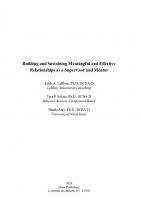Building and Sustaining Meaningful and Effective Relationships as a Supervisor and Mentor 1597381209, 9781597381208
Buy this book! The authors deserve recognition for their wonderful work. In this text, Linda LeBlanc, Tyra Sellers, and
477 34 50MB
English Pages 341 Year 2020
Table of contents :
Table of Contents
Section 1: Approach to Supervising and Mentoring
1. An Introduction to Supervision and Mentoring as Relationships
Definitions and Roles
Evolving Relationships
Activity 1: Identifying Your Supervisory Relationships
Activity 2: Current and Past Roles
2. Starting Strong in a Collaborative Supervisory Relationship
Strategies for Starting Strong
Activity: Exploring Collaboration Topics
Appendix: How to Talk About Feedback
3. Understanding Past and Current Supervisory and Mentored Relationships
Reflection and Values Determination
The Mentor Tree Activity
Examples from the Authors
Planning for Continued Development
Summary
Activity 1: The Mentor Tree
Activity 2: Planning for Continued Development
4. The Impact of Culture on Supervisory Relationships
Collaboration as a Supervisory Strategy
Behavior Analysis and Culture
Opportunities for Learning
Pathways to Cultural Responsiveness
Activity 1: Cultural Awareness Interviews
Activity 2: Exploring Your Place of Privilege
Activity 3: Exploring Your Perspective
Activity 4: Community of Practice Assessment
Activity 5: Cultural Satisfaction Survey for Employees and Supervisees
Section 2: Teaching Meaningful Repertoires
5. Using a Competency-Based Approach to Supervision
Considerations for a Competency-Based Curriculum
Determining Scope of Content and Skills
Addressing Ethics
Job Models and Curriculum
Determining Mastery Criteria
Considerations for Assessing Performance
On-Going Assessments
Considerations for Teaching Content
Appendix A: Tracking Competencies
Appendix B: Examples for Assessing Competency
Appendix C: Script for Explaining Feedback and Responding to Feedback
6. The Benefits of Learning from Experts and Self-Managing Development
Considerations for Identifying an Expert
Considerations for Teaching Effective Observing
Considerations for Teaching Effective Self-Observation and Reflection
Teaching Self-Management for Long-Term Success
Considering Communities of Practice as Long-Term Supports
Appendix A: Observational Learning Self-Checklist
Appendix B: Self-Management Planning
7. Structured Problem Solving Skills
Definitions: Problems and Problem-Solving
A Structured Approach to Problem-Solving
Problem Solving in the Supervisory Process
Appendix A: Problem Solving Worksheet
Appendix B: Assessing Common Difficulties with Problem
Solving
8. Organizational and Time Management Skills
OTM Skills
Appendix A: Sample Task Plan for Completing an Assessment Report
Appendix B: Agenda for Initial Supervision Session
Appendix C: Sample Agenda for Client Session
Appendix D: Assessing Organization and Time Management Issues
9. Interpersonal and Therapeutic Relationship Skills
Core Interpersonal Skills
Communication Skills
Noticing and Self-Reflection Skills
Perspective-Taking Skills
Compromising and Harmonizing Skills
Integrity
Applying the Core Skills in Different Contexts
Peer Workplace Relationships
Multi-Disciplinary Collaboration
Therapeutic Relationships with Clients and Families
Appendix A: Therapeutic Relationship Self-Evaluation
Appendix B: Assessing Difficulties with Interpersonal Skills and Therapeutic Relationships
Section 3: Evaluating Supervision and Building Career Resilience
10. Evaluating the Effects of Supervision
Evaluating Effects Using Data from the Client
Evaluating the Effects Using Data from the Supervisee
Evaluating the Effects Using Data from Caregivers and Others
Evaluating the Effects Using Data from the Supervisor
Appendix A: General “Check-In” Questions
Appendix B: Supervision Monitoring and Evaluation Form
11. Identifying and Resolving Problems in the Supervisory Relationship
Detecting Issues: Looking for Smoke
Detecting Indicators in the Supervisee’s Behavior
Detecting Indicators of Problems in the Supervisory Relationship inYour Own Behavior
Evaluating and Addressing Contributors to the Issue
Supervisor Self-Evaluation
Addressing Issues
Case Example —Multitasking while Supervising
Case Example —A Supervisor’s Harsh Feedback
Case Example —A Supervisee’s Immaturity
Ending the Supervisory Relationship
Conclusion
Appendix A: Looking for Smoke: Detecting Indicators of Issues in the Supervisory Relationship
Appendix B: Considerations to Determine Scope and Focus of the Issue
Appendix C: Self-Reflection on Supervisory Practices
Appendix D: Self Reflection on Personal History and Biases
12. Planning for a Sustained Career and Lifelong Growth
Transitioning into Your Career
Know Your Values and Reinforcers and Maintain Access to Them
Preventing and Addressing Burnout
Summary and Recommended Strategies for Sustained Career Engagement and Enjoyment
Appendix: Recommended Practices for Career Resilience and Enjoyment
Activity A: Identifying Your Preferred Work Activities
Activity B: Identifying Your Personal Reinforcers
13. Failures and Successes Are Teachers
Conclusion
References
Appendix I: BACB 5th Edition Task List
Appendix II: BACB Supervisory Training Outline .
Appendix III: BACB 5th Edition Task List Self-Assessment
Appendix IV: Additional Resources
Name Index
Subject Index
Table of Contents
Section 1: Approach to Supervising and Mentoring
1. An Introduction to Supervision and Mentoring as Relationships
Definitions and Roles
Evolving Relationships
Activity 1: Identifying Your Supervisory Relationships
Activity 2: Current and Past Roles
2. Starting Strong in a Collaborative Supervisory Relationship
Strategies for Starting Strong
Activity: Exploring Collaboration Topics
Appendix: How to Talk About Feedback
3. Understanding Past and Current Supervisory and Mentored Relationships
Reflection and Values Determination
The Mentor Tree Activity
Examples from the Authors
Planning for Continued Development
Summary
Activity 1: The Mentor Tree
Activity 2: Planning for Continued Development
4. The Impact of Culture on Supervisory Relationships
Collaboration as a Supervisory Strategy
Behavior Analysis and Culture
Opportunities for Learning
Pathways to Cultural Responsiveness
Activity 1: Cultural Awareness Interviews
Activity 2: Exploring Your Place of Privilege
Activity 3: Exploring Your Perspective
Activity 4: Community of Practice Assessment
Activity 5: Cultural Satisfaction Survey for Employees and Supervisees
Section 2: Teaching Meaningful Repertoires
5. Using a Competency-Based Approach to Supervision
Considerations for a Competency-Based Curriculum
Determining Scope of Content and Skills
Addressing Ethics
Job Models and Curriculum
Determining Mastery Criteria
Considerations for Assessing Performance
On-Going Assessments
Considerations for Teaching Content
Appendix A: Tracking Competencies
Appendix B: Examples for Assessing Competency
Appendix C: Script for Explaining Feedback and Responding to Feedback
6. The Benefits of Learning from Experts and Self-Managing Development
Considerations for Identifying an Expert
Considerations for Teaching Effective Observing
Considerations for Teaching Effective Self-Observation and Reflection
Teaching Self-Management for Long-Term Success
Considering Communities of Practice as Long-Term Supports
Appendix A: Observational Learning Self-Checklist
Appendix B: Self-Management Planning
7. Structured Problem Solving Skills
Definitions: Problems and Problem-Solving
A Structured Approach to Problem-Solving
Problem Solving in the Supervisory Process
Appendix A: Problem Solving Worksheet
Appendix B: Assessing Common Difficulties with Problem
Solving
8. Organizational and Time Management Skills
OTM Skills
Appendix A: Sample Task Plan for Completing an Assessment Report
Appendix B: Agenda for Initial Supervision Session
Appendix C: Sample Agenda for Client Session
Appendix D: Assessing Organization and Time Management Issues
9. Interpersonal and Therapeutic Relationship Skills
Core Interpersonal Skills
Communication Skills
Noticing and Self-Reflection Skills
Perspective-Taking Skills
Compromising and Harmonizing Skills
Integrity
Applying the Core Skills in Different Contexts
Peer Workplace Relationships
Multi-Disciplinary Collaboration
Therapeutic Relationships with Clients and Families
Appendix A: Therapeutic Relationship Self-Evaluation
Appendix B: Assessing Difficulties with Interpersonal Skills and Therapeutic Relationships
Section 3: Evaluating Supervision and Building Career Resilience
10. Evaluating the Effects of Supervision
Evaluating Effects Using Data from the Client
Evaluating the Effects Using Data from the Supervisee
Evaluating the Effects Using Data from Caregivers and Others
Evaluating the Effects Using Data from the Supervisor
Appendix A: General “Check-In” Questions
Appendix B: Supervision Monitoring and Evaluation Form
11. Identifying and Resolving Problems in the Supervisory Relationship
Detecting Issues: Looking for Smoke
Detecting Indicators in the Supervisee’s Behavior
Detecting Indicators of Problems in the Supervisory Relationship inYour Own Behavior
Evaluating and Addressing Contributors to the Issue
Supervisor Self-Evaluation
Addressing Issues
Case Example —Multitasking while Supervising
Case Example —A Supervisor’s Harsh Feedback
Case Example —A Supervisee’s Immaturity
Ending the Supervisory Relationship
Conclusion
Appendix A: Looking for Smoke: Detecting Indicators of Issues in the Supervisory Relationship
Appendix B: Considerations to Determine Scope and Focus of the Issue
Appendix C: Self-Reflection on Supervisory Practices
Appendix D: Self Reflection on Personal History and Biases
12. Planning for a Sustained Career and Lifelong Growth
Transitioning into Your Career
Know Your Values and Reinforcers and Maintain Access to Them
Preventing and Addressing Burnout
Summary and Recommended Strategies for Sustained Career Engagement and Enjoyment
Appendix: Recommended Practices for Career Resilience and Enjoyment
Activity A: Identifying Your Preferred Work Activities
Activity B: Identifying Your Personal Reinforcers
13. Failures and Successes Are Teachers
Conclusion
References
Appendix I: BACB 5th Edition Task List
Appendix II: BACB Supervisory Training Outline .
Appendix III: BACB 5th Edition Task List Self-Assessment
Appendix IV: Additional Resources
Name Index
Subject Index

- Author / Uploaded
- Linda. A LeBlanc
- Tyra P. Sellers
- Shahla Ala’i







![PLC at Work® and Your Small School : Building, Deepening, and Sustaining a Culture of Collaboration for Singletons (an Action Guide for Building an Effective PLC System in a Small School) [1 ed.]
9781949539622, 9781949539615](https://ebin.pub/img/200x200/plc-at-work-and-your-small-school-building-deepening-and-sustaining-a-culture-of-collaboration-for-singletons-an-action-guide-for-building-an-effective-plc-system-in-a-small-school-1nbsped-9781949539622-9781949539615.jpg)

